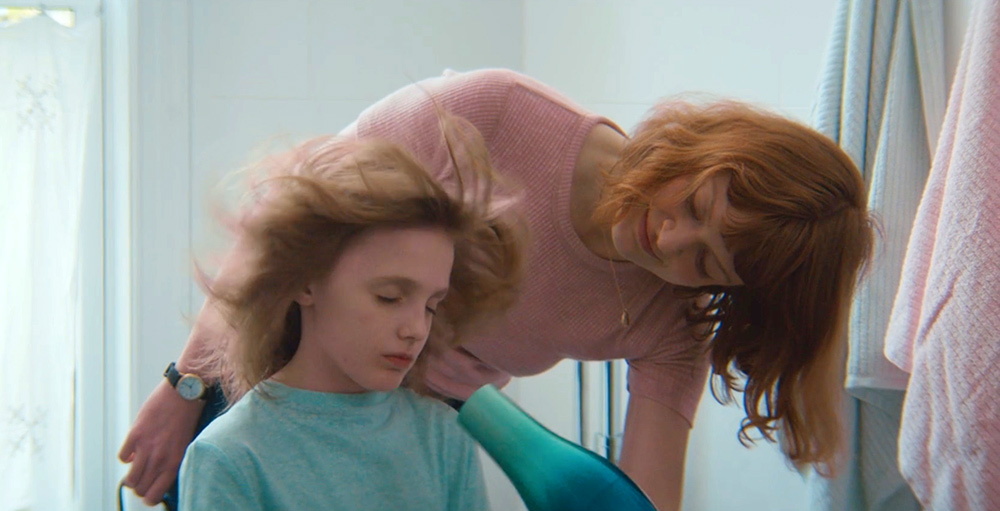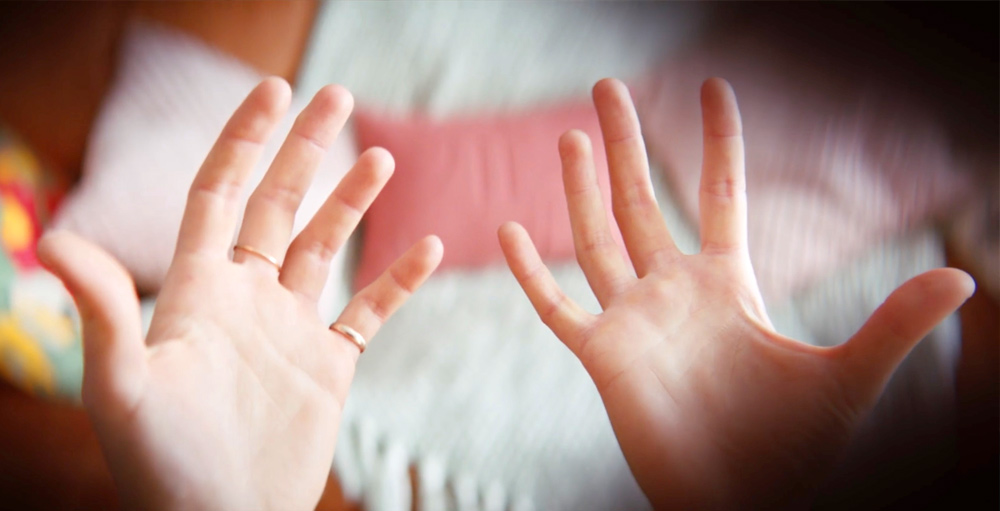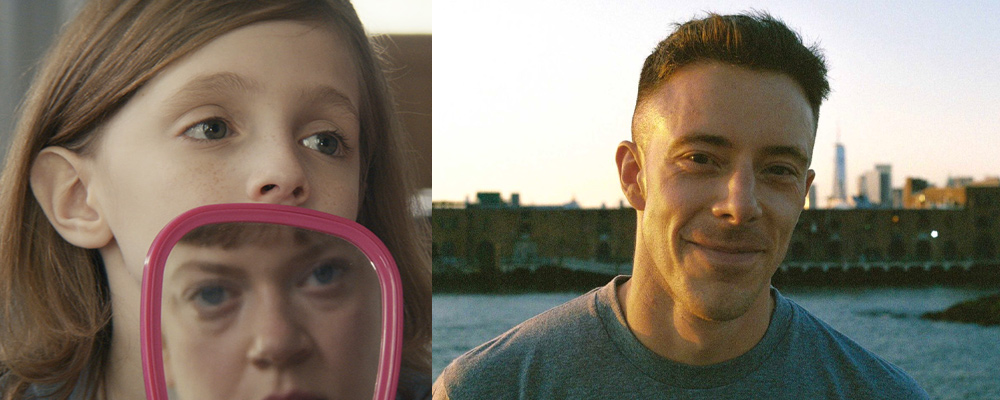Movies like Big, Freaky Friday and Being John Malkovich have tapped rich comic potential as bodies are variously exchanged, occupied or transformed by some mysterious agency, causing havoc (but also delight) as characters adapt to unusual circumstances and mind-blowing discoveries—and experience the universal fantasy of spending a day as someone else.
The indie comedy Homebody explores a new angle, adding gender to the mix. Nine-year-old Johnny (Tre Ryder), who is figuring out his own identity, employs a YouTube instructional video on “free spirit meditation” to dispatch his consciousness into the body of his beloved babysitter Melanie (Colby Minifie), who is saying goodbye to begin a career as a doula. Across the leafy sidewalks of brownstone Brooklyn, antics ensue—from a wild candy binge to a frantic encounter with Melanie’s not-exactly boyfriend to the sheer freakout of assisting in a home birth.
Now streaming exclusively on Fandor, Homebody is the debut feature from writer-director Joseph Sackett, who took inspiration from his own childhood fantasies, applying a personal touch that is at once tenderly observant of its young protagonist’s imaginative landscape and alert to all the manic possibilities suggested by the premise. The New York-based Sackett unpacks all the details in a recent conversation with Keyframe.

KEYFRAME: How did Homebody come together?
JOSEPH SACKETT: Back in 2017, I made a short film called I Was in Your Blood. At the time, I had no intention of expanding it. I cast Colby Minifie. She had been in one project I directed and I would later put her in another short film. She’s kind of a muse of mine. And also Tre Ryder. It’s about a little boy who’s in love with his babysitter. It’s an innocent version of love. It’s not a love that says, I want you. It’s a love that says I want to be you. At the end of that short, he dreams that his spirit floats into her body and can see the world through her point of view.
After finishing that short, I thought: what if we did the feature version? What if he did float into her body? Like, what if we did the Being John Malkovich version? On an emotional level, it’s coming from a very personal place. It’s very much inspired by my own genderqueer childhood. I had older babysitters who I wanted to be like and idolized. In a lot of ways, Homebody‘s a wish fulfillment fantasy from the point of view of my own younger self.
You’ve described the feature as a PG-13 version of a queer kid’s fantasy? That’s even more interesting given the weird culture war going on in the country right now.
I know, yeah. PG-13 is such a triggering word—not in a bad way. When my producer and I were taking this project with our sales agent out to distributors it was a big question: Where does this fit in the landscape? Who’s the audience for this? You just make the movie you want to make and figure the rest out later. At least, that was my approach. We always landed in this weird between space where it’s like a hard PG or a soft PG-13. There’s not really swearing. There is some innuendo, but not sex or nudity. Someone told us because there’s that one shot where we see a real birth sequence on Melanie’s phone that alone would—if we had gone through the MPAA—gotten it an R because you see a vagina during birth, but it’s not a sexualized moment.
Would you say that’s not a specific response to anything, so much as a personal expression?
I was excited to play in the genre. I’ve seen a lot of body-swap movies and watched a bunch researching this but had never seen a genderqueer take. I’m sure it’s out there. I’m not even a believer that you have to do it first. The point is doing it your way.

Did those movies prompt particular thoughts, in terms of subtext or how the scenarios function?
I remember reading this article saying the body-swap genre is the purest form of cinema. By that, this author meant that the original pleasure of cinema is seeing the world through someone else’s eyes. In a body-swap movie, the character gets to do that. They see the world through John Malkovich’s eyes, or their mom’s, or whatever. For a genderqueer little kid like me who both feared my feminine side and craved the experience of being a girl, the idea of living for a woman as a day, feeling what that would be like, was the ultimate fantasy and something out of reach of what our reality currently allows. Maybe that’s why it was such a potent fantasy that stayed with me, to the point where as an adult I made a whole movie about this deep-seated powerful fantasy I’d had as a kid.
How did you find the leads? You mentioned Colby Minifie was a muse, and she has gone on to higher-profile projects since. And the kid’s remarkable.
I waslucky because I had worked on the short with Tre and Colby, so I was able to write with them in mind. After that experience, I only want to write with an actor in mind, even if it’s an actor you can’t get. Imagining “How would Julianne Moore say this?” would make dialogue writing so much easier.
Colby’s got a part on “The Boys,” a part that’s gotten bigger and bigger. She’s on “Fear the Walking Dead” and “The Marvelous Mrs. Maisel.” She works a lot, so she’s a recognizable face to a lot of people. Luckily, when I brought this script to her and said, “I wrote this for you,” she was down to do it. Tre was a lucky find. We cast him two days before shooting the short. My producer and I were auditioning a bunch of kids. They were all good, but no one had that soul that I wanted, that sense that there’s a lot going on beneath the surface. The very last kid we auditioned was Tre, and he was so good, and his mom is great, which is important because when you’re casting a kid, you’re also casting the parent. His whole family’s awesome.

Minifie pulls off some adept physical comedy, playing a little boy in a grown woman’s body. How did you all come up with that choreography?
We would do these two-part rehearsals. The first part was Colby and Tre together, and we would do simple stuff: draw pictures together, do dances, chat. It was very low-key, not like a formal rehearsal, but really Colby was observing Tre, listening to how he talked, watching how he would tie his shoe or fidget when he thought no one was watching. The second half of the rehearsal would be Colby and I recreating: How did he sit in his chair? Redraw this picture that he drew. Slump over the way he did. She got a lot of time to study his physicality in the process. They’d known each other for a long time, so they had a rapport. Colby is very talented, great to work with and very, very open on set as we were shooting. She would discover things. There’s a moment where we see Johnny-as-Melanie peeing and when she went to wipe got so, so much toilet paper, an obscene amount. That was an inspiration of hers.
Both actors are terrific at capturing childhood mischief, imagination, and the thrill/fear of discovering a brave new world. Was it easy for you to tap into those youthful feelings?
It did feel pretty easy to tap into my child’s mindset again. When I was growing up, I watched whatever gay content I could get my hands on. There wasn’t that much of it. A lot of it was trauma based, which is not necessarily a critique because there’s space for exploring the heavy and the lighter parts of life. But I will say when I wrote this, it was important to me to show a genderqueer young person experiencing joy and having fun. Although there is both light and shadow in Homebody, I knew I wanted it to be a joyful experience overall. I wanted a happy ending.




